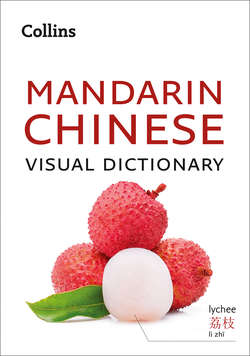Читать книгу Collins Mandarin Chinese Visual Dictionary - Collins Dictionaries - Страница 5
INTRODUCTION
ОглавлениеWhether you’re on holiday or staying for a slightly longer period of time, your Collins Visual Dictionary is designed to help you find exactly what you need, when you need it. With over a thousand clear and helpful images, you can quickly locate the vocabulary you are looking for.
The Visual Dictionary includes:
10 chapters arranged thematically, so that you can easily find what you need to suit the situation
images – illustrating essential items
YOU MIGHT SAY… – common phrases that you might want to use
YOU MIGHT HEAR… – common phrases that you might come across
VOCABULARY – common words that you might need
YOU SHOULD KNOW… – tips about local customs or etiquette
USING YOUR COLLINS VISUAL DICTIONARY
The points set out below will help to make sure that your Collins Visual Dictionary gives you as much help as possible when using Mandarin Chinese:
1) How to address people politely
At work, you can call your peers by their names – a rule of thumb is to always address people by their job title or occupation with their family name first, for example, 张老师 (zhāng lǎo shī), “Zhang teacher”. You may also hear 小王 (xiǎo Wang), literally “young Wang” or 老李 (lǎo Lǐ), “old Li” in the workplace depending on age and seniority, although this is rather informal.
When invited to meet a friend’s family, unless they are younger or roughly the same age, you shouldn’t call them by their names. You can call their grandparents 爷爷/奶奶 (yé ye/nǎi nai) “grandfather/grandmother”, and their parents or anyone in that generation 叔叔/阿姨 (shū shu/ā yí) “uncle/auntie”, as if they were your own relatives. Addressing the older generations by their names is considered very rude in Chinese culture.
“你” or “您”? Although both are translated as “you” in English, 您 is used to show respect when addressing, for example, your parents, grandparents, or boss. On the other hand, 你 is used to address friends and peers.
2) Measure words
Measure words are unique to Chinese, and are mandatory when using a noun with a numeral, for example, “one car” is 一辆车 (yī liàng chē) and “three bedrooms” is 三间卧室 (sān jiān wò shì). In these cases, the measure words are 辆 (liàng) and 间 (jiān) respectively. There are many different measure words in Chinese, and they are used for different types of objects. The most common measure word is 个 (gè) and this can be treated as a “default option” when you don’t know the exact measure word to use.
3) Tones for 一 and 不
To maintain consistency, we use yī (first tone) as the Pinyin for the character 一 and bù (fourth tone) for the character 不. This is in line with the authoritative Contemporary Chinese Dictionary. However, the pronunciations for these two characters may vary according to the tones of the characters that proceed or follow them, as shown below:
| 一 | TONE | EXAMPLES |
| When it’s the last character of a phrase or sentence | First tone | 第一 (dì yī) first统一 (tǒng yī) unity |
| When followed by characters of the first, second, and third tones | Fourth tone | 一天 (yì tiān) one day一起 (yì qǐ) together |
| When followed by characters of the fourth tone | Second tone | 一夜 (yí yè) one night一切 (yí qiè) all |
| 不 | TONE | EXAMPLES |
| When it’s the last character of a phrase or sentence | Fourth tone | 绝不 (jué bù) never也不 (yě bù) nor |
| When followed by characters of the first, second, and third tones | Fourth tone | 不行 (bù xíng) no不好 (bù hǎo) bad |
| When followed by characters of the fourth tone | Second tone | 不错 (bú cuò) good不去 (bú qù) not going to |
FREE AUDIO
We have created a free audio resource to help you learn and practise the Chinese words for all of the images shown in this dictionary. The Chinese words in each chapter are spoken by native speakers, giving you the opportunity to listen to each word twice and repeat it yourself. Download the audio from the website below to learn all of the vocabulary you need for communicating in Chinese.
www.collinsdictionary.com/resources
